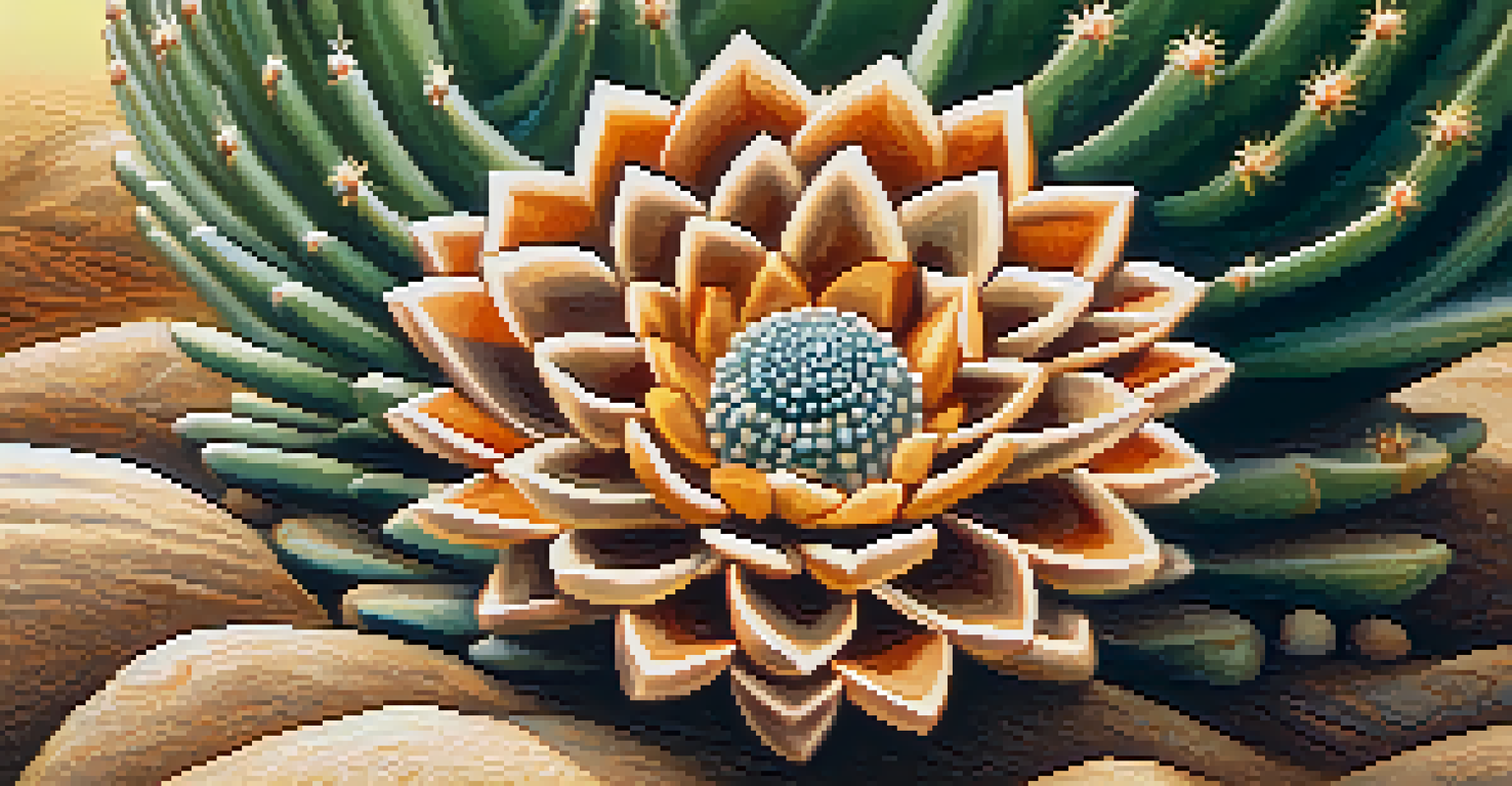The Role of Peyote in Native American Spiritual Traditions

Understanding Peyote: A Cactus with Deep Roots
Peyote, scientifically known as Lophophora williamsii, is a small cactus native to the southwestern United States and Mexico. It contains mescaline, a psychoactive compound that has been used for thousands of years in various spiritual rituals. For many Native American tribes, peyote is not just a plant; it is a sacred tool for connecting with the spiritual world.
The use of peyote is deeply intertwined with the cultural identity of many Native American communities.
The use of peyote is deeply intertwined with the cultural identity of many Native American communities. It serves as a bridge between the physical and spiritual realms, allowing practitioners to access deeper levels of consciousness. This relationship with peyote is nurtured through tradition, teachings, and communal experiences.
Understanding peyote's role in these cultures requires respect and recognition of its significance. It is not merely a recreational substance; rather, it is a revered part of Native American spiritual heritage, often seen as a gift from the creator.
Historical Context: Peyote's Journey Through Time
Peyote use can be traced back to ancient times, with evidence suggesting its consumption by indigenous peoples for over 5,000 years. Archaeological findings, such as peyote buttons in burial sites, highlight its importance in ancient rituals. As European settlers arrived, they encountered this unique tradition, which sparked both curiosity and conflict.

The early interactions between Native Americans and colonizers often led to misunderstandings, particularly regarding the use of peyote. For some, the plant was viewed with suspicion, leading to attempts to suppress its use. However, many tribes persisted, incorporating peyote into their spiritual practices as a form of resistance and resilience.
Peyote: A Sacred Cactus
Peyote is a small cactus integral to Native American spirituality, used for connecting with the divine through ceremonial practices.
Today, the historical journey of peyote reflects broader themes of cultural survival and adaptation. Native American Church members and other groups continue to advocate for the right to use peyote in ceremonies, emphasizing its enduring role in spiritual identity.
Ceremonial Use: The Peyote Ceremony Explained
The peyote ceremony is a structured spiritual gathering that often lasts all night, bringing together community members for prayer, singing, and sharing. During the ceremony, participants consume peyote in a sacred setting, guided by a leader known as a roadman. This leader facilitates the experience, ensuring it remains respectful and spiritually focused.
Recognizing the deep-rooted traditions associated with peyote can enhance our appreciation for its spiritual dimensions.
Central to the ceremony is the belief that peyote allows individuals to connect with the divine and gain insight into their lives. Participants often report profound experiences, including visions that provide guidance, healing, and clarity. These transformative moments foster a deeper sense of community and shared purpose.
The peyote ceremony is much more than a drug experience; it is a holistic journey that encompasses physical, emotional, and spiritual dimensions. Through this sacred practice, participants reaffirm their cultural identity and strengthen their bonds with one another and the natural world.
Cultural Significance: Peyote and Identity
For many Native American tribes, peyote is a cornerstone of cultural identity and spirituality. It represents a connection to the land, ancestors, and the larger cosmos. Engaging with peyote in ceremonial contexts helps individuals affirm their heritage and maintain their cultural practices across generations.
The spiritual significance of peyote extends beyond individual experiences; it also strengthens communal ties. Sharing peyote in ceremony fosters a sense of belonging and collective understanding among participants. This shared journey can be especially powerful for younger generations seeking to reconnect with their roots.
Cultural Identity and Community
For many tribes, peyote reinforces cultural identity and fosters communal ties, allowing individuals to affirm their heritage.
Moreover, peyote's role in cultural identity has led to the formation of organizations dedicated to its preservation and responsible use. These groups advocate for the spiritual rights of Native Americans, ensuring that peyote remains an integral part of their traditions.
Modern Challenges: Legal and Social Issues
Despite its deep cultural significance, the use of peyote faces numerous challenges in contemporary society. Legal restrictions in the United States often complicate its availability for ceremonial use. While the American Indian Religious Freedom Act allows for its use, the reality is that many tribes struggle with access due to regulatory hurdles.
In addition to legal challenges, there is ongoing concern about peyote’s sustainability. Overharvesting and habitat loss threaten peyote populations, raising questions about its future availability for ceremonial purposes. This situation calls for a collective effort to protect this sacred plant and its ecological environment.
Furthermore, as interest in psychedelics grows in mainstream culture, there is a risk of cultural appropriation. It’s crucial for non-Native individuals to approach peyote with respect and understanding, recognizing its sacred status in Native American spirituality rather than treating it as a mere substance for recreational use.
Peyote in Contemporary Spiritual Practices
In recent years, there has been a resurgence of interest in peyote among both Native Americans and non-Native individuals seeking spiritual growth. Many are drawn to its potential for healing and self-discovery, often participating in ceremonies led by Native American practitioners. This interest has sparked discussions around the ethics of such practices.
Contemporary spiritual movements sometimes incorporate peyote as part of broader psychedelic experiences, which can dilute its traditional meaning. While some seek authentic connections with indigenous practices, others may unintentionally misinterpret or commercialize these sacred traditions. This underscores the importance of education and respectful engagement.
Challenges Facing Peyote Use
Peyote faces legal and sustainability challenges, highlighting the need for respectful engagement and preservation of this sacred plant.
Ultimately, the ongoing dialogue around peyote in modern spirituality reflects a larger conversation about cultural respect, identity, and the importance of preserving sacred traditions. By approaching peyote with humility and reverence, individuals can foster a deeper appreciation for its role in Native American spirituality.
Conclusion: Embracing the Sacredness of Peyote
Peyote holds a profound place within Native American spiritual traditions, serving as a medium for connection, healing, and cultural identity. Its historical journey, ceremonial use, and contemporary relevance highlight the complexities surrounding this sacred plant. As society grapples with its meaning and significance, it is vital to approach peyote with respect and understanding.
Recognizing the deep-rooted traditions associated with peyote can enhance our appreciation for its spiritual dimensions. Engaging in respectful dialogue and education around its use fosters a greater understanding of Native American cultures and their ongoing struggles for rights and recognition.

Ultimately, embracing the sacredness of peyote invites us all to reflect on our own spiritual journeys while honoring the rich histories and practices of those who have cherished this plant for centuries.